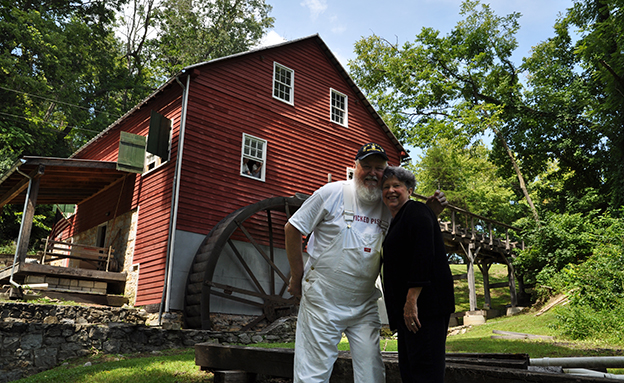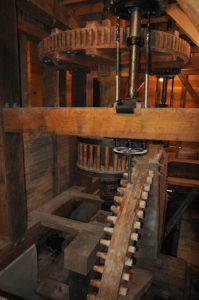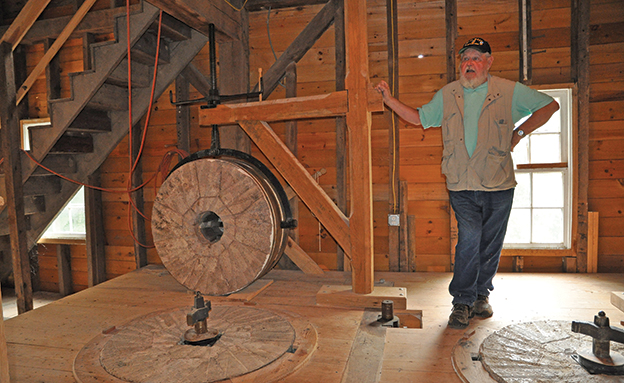Locke’s Mill flourishes after nearly two-and-a-half centuries.
Story and photography by Betsy Arnett
 Jon Joyce never intended to become an expert on 18th-century grist mills or to spend almost 20 years restoring one.
Jon Joyce never intended to become an expert on 18th-century grist mills or to spend almost 20 years restoring one.
“But then I fell in love with a lady who owned a mill,” he says with a smile.
Jon’s wife, Carol, was an avid kayaker and wanted to purchase property with river access. Living in Arlington, she started looking along the Potomac River and worked her way west to the Shenandoah River in Clarke County. When she found Locke’s Mill in late 1991, the property was so overgrown that the mill building wasn’t visible from the road.
“I called the number on the dilapidated ‘for sale by owner’ sign,” Carol remembers. “The mill had been on the market for over three years, listed not as a mill, but as an abandoned warehouse. The waterwheel and all of the gears were long gone.”
Carol’s original plan was to convert the building into a loft residence, so her first step was to hire a soil scientist to determine if a septic system could be installed. When the soil testing came back with positive results, she called the owner and made an offer, based on the assessed value and her estimate of how much it would cost to make the building habitable.
“I explained to the estate representative how I got to that amount, which was much lower than the asking price. She thought about it for a while, and then told me, ‘You know, Carol, I think you’re the right person to buy the mill, so I’m going to accept your offer.’ That’s how I came to be the proud owner of an old grist mill,” Carol recalls. About a year later, she purchased the adjoining property with an old 1960s fishing cottage, which she used as weekend sleeping quarters. It was one step above camping on the top floor of the mill.
After Carol purchased the mill, her father gave her a stack of Old Mill News magazines and told her that his great-great-grandfather had been a miller in Jefferson, Md.
“Once I knew about the family connection to milling, I began to dream of restoring the mill,” Carol says.
A couple of years after buying Locke’s Mill, Carol began dating Jon, whom she met through a mutual friend and co-worker. She invited him to 18th Century Days at the Burwell-Morgan Mill, another 18th-century grist mill in Clarke County. The Burwell-Morgan Mill was built in 1785 by Nathaniel Burwell and Daniel Morgan on Spout Run, a tributary of the Shenandoah. The village of Millwood grew up around the mill, which operated until the early 1950s. Today, the Burwell-Morgan Mill is a working mill museum, owned and operated by the Clarke County Historical Association.
“I thought we were going to 18th Century Days as spectators,” Jon remembers. “But the next thing I knew, I was in a period costume, learning how to grind corn and dress millstones.”
History
A mill was first constructed on the Locke’s Mill site between 1740 and 1751; Robert Carter Nicholas, a grandson of Robert “King” Carter, inherited the property from his grandfather’s estate in 1740, and the survey made by John Mausey in November 1751, when Nicholas sold the property to Colonel Fielding Lewis, shows an operational mill on the site.
 An archaeological study completed in 1997 indicates that the original mill was closer to the river. There may have been two mills operating on the property at the same time. The second, and present, mill was constructed by Fielding Lewis sometime before 1777. A mill ledger from that year references both an upper mill and a lower mill. The property changed hands several times before Joseph Price purchased it in 1876, rebuilt the mill frame and installed new millstones. The mill was known as Price’s Mill until Thomas H. Locke purchased it in 1907. When the mill ceased operations is not certain, but a photograph taken in the 1920s shows the wooden waterwheel in disrepair. The same photo also shows the mill’s original fourth level and what appears to be a sawmill attached to the waterwheel. The sawmill would have been an additional source of year-round income.
An archaeological study completed in 1997 indicates that the original mill was closer to the river. There may have been two mills operating on the property at the same time. The second, and present, mill was constructed by Fielding Lewis sometime before 1777. A mill ledger from that year references both an upper mill and a lower mill. The property changed hands several times before Joseph Price purchased it in 1876, rebuilt the mill frame and installed new millstones. The mill was known as Price’s Mill until Thomas H. Locke purchased it in 1907. When the mill ceased operations is not certain, but a photograph taken in the 1920s shows the wooden waterwheel in disrepair. The same photo also shows the mill’s original fourth level and what appears to be a sawmill attached to the waterwheel. The sawmill would have been an additional source of year-round income.
Restoration of the mill building
Jon and Carol married in April 1997 and began the restoration of Locke’s Mill by stabilizing the building, starting with the foundation and working their way up. In addition to the waterwheel and gears, most of the back wall and the ground level floor were missing as well. The gear pit and half of the ground level was filled with dirt, the result of flooding. They hand-dug the dirt out, installed new floor joists and flooring, and then jacked up the entire building in order to install new vertical post and summer beam.
“We would come out on weekends to work on the mill,” Jon, a retired Navy master chief petty officer, says. “Carol’s plan was still to convert the third level into a miller’s loft and possibly rebuild the fourth level.”
However, getting the septic system approved by Clarke County, given the property’s proximity to the Shenandoah River, proved difficult. Carol had three separate systems designed and presented to the Clarke County Planning Commission. After allowing a variance to the county ordinance because the mill is an historic building, the County finally gave the third design a thumbs up. As it turned out, though, the Joyces never installed the system.
“Once we decided to restore the mill to working order, in talking with other mill owners, we learned flour dust is a real problem. It gets everywhere and is a fire hazard,” Carol says.
Both Carol and Jon were getting ready to retire from the Navy, Carol as an electrical engineer for the Space and Naval Warfare Systems Command and Jon, this time as a civilian, from the Naval Sea Systems Command.
“We decided that living on the third floor of a mill wasn’t a good long-term option for us as a retirement home,” Jon laughs. The Joyces demolished the fishing cottage and built a new house on the site in 2002. It was then the the Joyces began to restore the building to a operational gristmill, true to its history.
Restoring a working mill
In 1996, the Joyces hired Derek Ogden, a millwright and mill restoration expert, to draw up plans for a new Hurst frame and gears, patterned after a mill in Pennsylvania. The Hurst frame holds the gears in place and is structurally completely independent of the mill building; otherwise, the vibration from the gears would shake the building apart. The new frame and gears are white oak, which the Joyces purchased green and air-dried in the mill for eight years.
“We could have restored the mill more quickly,” Jon explains. “But it would have cost a lot more money.”
All of the mill’s gears and machinery on the ground level had to be replaced. Millwright Ben Hassett, based at the time in Lynchburg, constructed the new gears from the air-dried white oak and red maple, using Ogden’s plans. Hassett, now located in Louisville, Ky., has restored grist mills and windmills across the country, including the grist mill at Stratford Hall Plantation, the historic home of the Lee family in Westmoreland County.
Jon believes their restoration of Locke’s Mill was guided in part by divine intervention.
“Whatever part we needed next, one would come on the market or we would meet someone who knew someone who had one they were trying to get rid of,” he says. The mill’s “new” floor joists came from an old refrigerator plant.
In 1997, long before the mill’s new gears were built, Derek Ogden heard about an available waterwheel in southern Virginia. The wheel had come from Clay’s Mill on the Staunton River in Wren. Clay’s Mill burned down in 1926, but water from the sluice had kept the wheel, made of a steel and iron alloy, from warping. In 1954, Jack Poindexter, a local farmer, moved the wheel to his home and mounted it on cement piers in his front yard, simply because he and his wife had fond memories of the old mill. Carol says it looked like a giant hamster wheel. After Jack sold the property, the new owner thought it was a liability and wanted the wheel removed. Hoping the wheel could be installed in a mill again, Jack contacted Derek, who contacted the Joyces. After some negotiation, Carol and Jon bought the wheel and moved it to Locke’s Mill.
Manufactured in Hanover, Pa., by the Fitz Water Wheel Company, the water wheel is 23 feet in diameter, three feet wide, and weighs six tons. According to Jon, they spent about $2,300 moving the wheel from southern Virginia and another $1,000 repairing it. A new wheel would have cost upwards of $80,000.
“What are the odds of finding a waterwheel of exactly the right dimensions at exactly right time?” Jon asks. “Must be divine intervention!”
The Joyces have been as faithful to the mill’s original design as they can. While they had to completely replace the mill machinery on the ground level, the “mill furniture” on the second level where the grinding takes place is mostly original. The millstones are the ones installed by James Price in 1876. Manufactured in Baltimore, the French burrstones (or Burh stones) are comprised of 10 or more pieces of white quartz bound by plaster and a metal band around the outside edge. The original bands were stolen for scrap metal during World War II.
There were two changes the Joyces needed to make that varied from what would have been a more exact historical replication. The first change to the mill’s design the Joyces made was to install two stationary cranes made of white oak, one for each set of millstones, to replace the original moveable pine crane. The cranes lift the “runner stones” off the “bed stones” for cleaning and dressing. When grinding, only the top runner stones turn; the bed stones do not move. Over time, the grooves in the millstones get worn down and new grooves must to be cut into the stones by hand, a process known as dressing the stones. Most commercial grist mills in the Shenandoah Valley had two sets of millstones, one for wheat and one with deeper grooves for corn. Because no two sets of millstones are the same, every mill produces a unique texture.
The other major change the Joyces made wasn’t to the mill itself, but to its power supply. The mill’s head race is fed by a freshwater spring. Originally, there was a mill pond on the mountainside above the mill. The miller would close the gate to the head race at night and let the pond fill up. In the morning, the gate would be opened, allowing water to flow down the head race and into the mill flume, turning the waterwheel. While the remnants of that original pond still exist, there are now houses below it. Instead of restoring the original mill pond and relying on gravity to power the mill, the Joyces built a new mill pond below the waterwheel and pump the water from there up into flume.
Community
There is a large, well-connected community of grist mill enthusiasts. During their 20-plus-year journey to restore Locke’s Mill, Carol and Jon became very active, joining both the Society for the Preservation of Old Mills (SPOOM) and The International Molinological Society (TIMS). They were instrumental in founding TIMS – America and bringing the TIMS International Mill Symposium, held every three or four years, to Virginia in 2000.
 “Leading up to the symposium, we hosted a series of workshops here at Locke’s Mill,” Carol recalls. “One workshop was on how to put iron bands on millstones, since our millstones were missing their bands. We built a fire in front of the mill and heated the bands to red hot, and then carried them into the mill to put them on the millstones. The heated metal bands shrank as they cooled to fit tightly around the millstones.”
“Leading up to the symposium, we hosted a series of workshops here at Locke’s Mill,” Carol recalls. “One workshop was on how to put iron bands on millstones, since our millstones were missing their bands. We built a fire in front of the mill and heated the bands to red hot, and then carried them into the mill to put them on the millstones. The heated metal bands shrank as they cooled to fit tightly around the millstones.”
Grinding at the Operational Mill
In 2012, 20 years after Carol purchased the mill, the restoration was complete and they were ready to start grinding. Their first customer was Trent Tebbe, owner of Three Monkeys Farm in Loudoun County. Trent was looking for someone to grind organic rye for Silverback Distillery in Afton, Va. Through word of mouth, Trent heard about the Joyces and Locke’s Mill. On their first grinding run, they ground seven tons of rye and delivered it to Silverback and another distillery in Culpeper. Word spread and today, the Joyces grind mostly rye, almost exclusively for distilleries. Depending on demand, they can grind about two and a half tons of grain in one day.
“Once a distillery tries us, they always come back,” Jon says with pride.
One reason for their customers’ loyalty is Jon’s willingness to customize the grinding. As Jon explains, there are three variables that determine grinding texture: first, the speed of the waterwheel; second, the gap between the millstones; and finally, how fast the grain is fed into the millstones. Jon will experiment, making adjustments to all three factors in order to get the specific texture his customers want. Another advantage to small-batch grinding is that the millstones don’t heat up.
“If the stones get too hot, they’ll toast the grain,” Jon explains. Toasting the grain changes its texture and taste.
The Joyces no longer own Locke’s Mill, but Jon continues to operate the mill for the new owner, Sandy Lerner. An advocate of sustainable, humane, and organic farming, Sandy owns Ayrshire Farm in Loudoun County, Hunter’s Head Tavern in Upperville, and Gentle Harvest, an organic grocery and café in Marshall.
At Sandy’s request, Jon had one set of millstones certified organic by the U.S. Department of Agriculture. The certification process focused on demonstrating how they will keep the organic and non-organic grains separate throughout the grinding process.
“We’re the only historic stone grist mill on the east coast that is USDA certified organic,” Jon says. “And maybe the only one the United States.”
This past summer, Jon began grinding rye for Katie Kopsick, the pastry chef at Hunter’s Head and Gentle Harvest. Currently, Katie used the rye flour only to bake cranberry walnut sourdough bread. Now that the mill is certified organic, she wants to obtain most, if not all, of her ground grains from Locke’s Mill. Jon is actively looking for sources of other organic grains.
One Sunday afternoon last August, Jon and two other millers, Roger Stayaert and Harry Lewis, ground 100 pounds of rye into flour for Katie. The whole job, from start to clean up, took about two and a half hours. Jon was pleased with the result and said that it was the finest flour they’d ground so far.
When asked how long he intends to continue operating Locke’s Mill, Jon shrugs and shakes his head.
“As long as Sandy wants me to, I guess,” he says.
After putting 20 years of love into restoring the mill, Jon and Carol are relieved the mill’s new owner plans to maintain and operate it long into the future. For now, they’re happy to continue to be a part of Locke’s Mill.
What a great story!
Jon and Carol: Cherie and I purchased property in Sussex County, DE in 2010? and on it was a Mill built by the Poole family which was granted the Poole’s in 1762 by Lord Calvert of Baltimore.
We spent many hours and dollars trying to get the mill into operation which had been idle since the 1950’s. The thieves and local folks won the battle of stealing and we finally gave up, we had the mill destroyed and hauled off.
I can only imagine what you folks must have gone through in your lengthy ordeal; HURRAH to you folks.